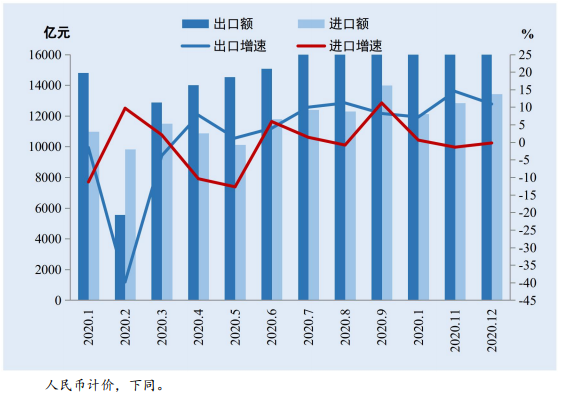Original Title: Report on China’s Foreign Trade Situation in the Spring of 2021 (Excerpt)
(1) The scale of trade and international market share both hit a record high
In 2020, Chinese goodsimport and exportA total of 32.2 trillion yuan, an increase of 1.9%, is the only major economy in the world that has achieved positive trade growth. Among them, exports were 17.9 trillion yuan, an increase of 4%; imports were 14.2 trillion yuan, a decrease of 0.7%; the trade surplus was 3.7 trillion yuan, an increase of 27.4%. The scale of imports and exports throughout the year hit a record high. According to data from the World Trade Organization (WTO), China’s export growth rate in 2020 is 7.4% higher than that of the global market. The international market share of import and export, export and import reached 13.1%, 14.7%, and 11.5% respectively, all hitting historical highs. The status of a major country has been further consolidated.
China’s monthly import and export scale and growth rate in 2020
(2) Market diversification has achieved remarkable results, and the regional layout has become more balanced
In 2020, China’s imports and exports to the top five trading partners ASEAN, the European Union, the United States, Japan, and South Korea will be 4.7 trillion yuan, 4.5 trillion yuan, 4.1 trillion yuan, 2.2 trillion yuan, and 2.0 trillion yuan, respectively. Accounted for 54.3% of total imports and exports, among which ASEAN became China’s largest trading partner for the first time. Imports and exports to countries along the “Belt and Road” were 9.4 trillion yuan, accounting for 29.1% of total imports and exports. Imports and exports to ASEAN, the EU, and the United States increased by 7%, 5.3%, and 8.8%, respectively, which were 5.1, 3.4, and 6.9 percentage points higher than the overall growth rate.
The amount and proportion of China’s imports and exports to major trading partners in 2020
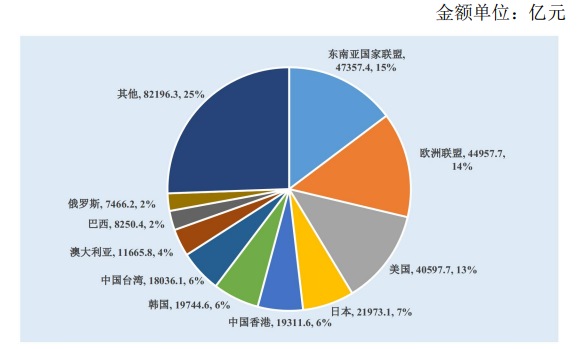
(3) The rapid growth of import and export of private enterprises,Main forceThe military position is more consolidated
In 2020, China has 531,000 foreign trade companies with actual import and export performance, an increase of 6.2% over the previous year. The import and export of private enterprises was 15.1 trillion yuan, an increase of 10.6%, which was 8.7 percentage points higher than the overall growth rate. It drove the overall import and export growth by 4.6 percentage points, accounting for 47% of the total import and export volume, an increase of 3.7 percentage points from the previous year.
(4) The commodity structure continues to upgrade, and the export of epidemic prevention materials has a prominent effect
From the perspective of exports, the product structure has been further optimized. In 2020, China’s exports of mechanical and electrical products were 10.7 trillion yuan, an increase of 6%, 2 percentage points higher than the overall export growth rate, and accounted for 59.4% of the total export value, an increase of 1.1 percentage points from the previous year.
From the perspective of imports, China’s ultra-large-scale market advantage has been highlighted under the epidemic, providing strong support for the expansion of imports. In 2020, China’s imports of resource-based products such as coal, crude oil, natural gas, and iron ore will increase by 1.5%, 7.3%, 5.3% and 9.5% respectively.
The value and proportion of China’s main export commodities in 2020
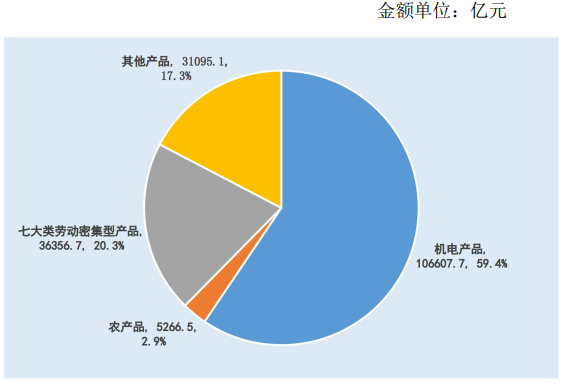
(5) Trade methods have been further optimized, and new business formats and new models have developed vigorously
The contribution of general trade continued to increase. In 2020, imports and exports of general trade were 19.3 trillion yuan, an increase of 3.4%, accounting for 59.9% of total imports and exports, an increase of 0.9 percentage points over the previous year.
The pace of innovation and development of foreign trade has accelerated. The high-level open platform played a significant role. Imports and exports in the comprehensive bonded zone increased by 17.4%, the import and export in the pilot free trade zone increased by 10.7%, and the import of duty-free goods in the Hainan Free Trade Port increased by 80.5%.
(6) The deficit in service trade has narrowed substantially, and the structure of service trade has continued to be optimized
In 2020, China’s service import and export totaled 4,564.27 billion yuan, down 15.7%, and the rate of decline narrowed quarter by quarter. The structure of service trade continued to be optimized, and the proportion of imports and exports of knowledge-intensive services increased significantly. In 2020, the import and export of knowledge-intensive services was 2033.12 billion yuan, an increase of 8.3%, accounting for 44.5% of the total service import and export, an increase of 9.9 percentage points from the previous year.
2. China’s foreign trade development since 2021
(1) The growth rate of import and export and export hit the highest level in the same period in 10 years
In the first four months, China’s total import and export of goods was 11.6 trillion yuan, an increase of 28.5%, and an average increase of 10.6% in the two years. Among them, exports were 6.3 trillion yuan, an increase of 33.8%, an average increase of 11.8% in two years; imports were 5.3 trillion yuan, an increase of 22.7%, and an average increase of 9.2% in two years; the trade surplus was 1.0 trillion yuan, an increase of 147%. In US dollars, the total import and export volume was 1.8 trillion US dollars, an increase of 38.2%, and an average growth rate of 13.1% over the two years. Among them, exports were 973.7 billion US dollars, an increase of 44%, and the two-year average growth was 14.4%; imports were 815.79 billion US dollars, an increase of 31.9%, and the two-year average growth was 11.6%; the trade surplus was 157.91 billion US dollars, an increase of 171%.
China’s monthly import and export scale and growth rate since 2021

(2) The proportion of general trade imports and exports has further increased
In the first four months, general trade import and export was 7.2 trillion yuan, an increase of 32.3%, accounting for 61.6% of the total import and export value, an increase of 1.8 percentage points over the same period last year.
Table of China’s import and export trade methods from January to April 2021
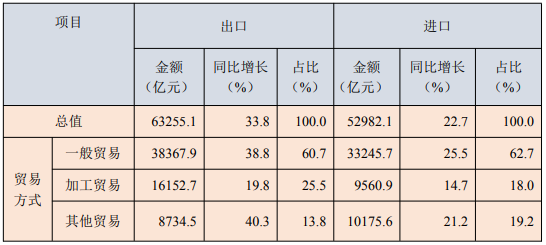
(3) Maintaining growth in imports and exports with major trading partners
In the first four months, ASEAN continued to maintain its position as China’s largest trading partner. Imports and exports to ASEAN were 1.7 trillion yuan, an increase of 27.6%, accounting for 14.8% of the total value of imports and exports, of which exports were 950.58 billion yuan, an increase of 29%; imports 765.05 billion yuan, an increase of 25.9%; a surplus of 185.53 billion yuan, an increase of 40.2%. Imports and exports to the European Union, the United States and Japan were 1.6 trillion yuan, 1.4 trillion yuan and 770.64 billion yuan, an increase of 32.1%, 50.3% and 16.2% respectively. Imports and exports to countries along the “Belt and Road” totaled 3.4 trillion yuan, an increase of 24.8%, of which exports were 2.0 trillion yuan, an increase of 29.5%; imports were 1.5 trillion yuan, an increase of 19.3%.
China’s import and export value and proportion with the top ten trading partners in the first 4 months of 2021
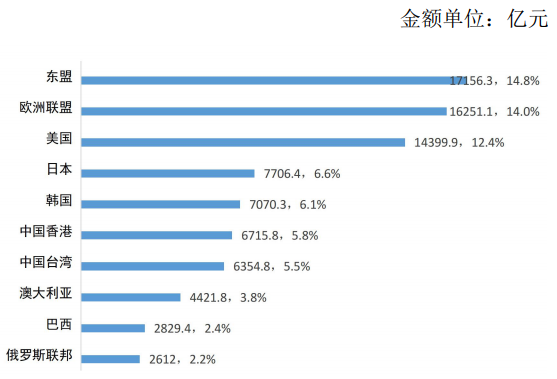
(4) Private enterprises continue to maintain their position as the largest foreign trade operator
In the first four months, the import and export of private enterprises was 5.5 trillion yuan, an increase of 40.1%, which was 12 percentage points higher than the overall growth rate, and accounted for 47.6% of the total import and export value, which was an increase of 4.1 percentage points from the same period last year. It was the largest increase in foreign trade import and export. The main pulling force.
(5) The proportion of imports and exports in the central and western regions continues to increase
In the first four months, the import and export of the central and western regions was 2.1 trillion yuan, an increase of 37.6%, which was 9.1 percentage points higher than the overall growth rate. The proportion of imports and exports in the country increased by 1.2 percentage points compared with the same period last year, reaching 17.7%.
(6) Rapid growth in exports of mechanical and electrical products and labor-intensive products
In the first four months, the export of mechanical and electrical products was 3.8 trillion yuan, an increase of 36.3%, accounting for 59.9% of the total export value, an increase of 1.1 percentage points from the same period last year.
Table of the Values of China’s Major Export Commodities in the First 4 Months of 2021

(7) Import volume and price of some bulk commodities have risen
The domestic manufacturing industry has rebounded further, driving the power of electrical products, energy resources,Agricultural productsWait for the rapid growth of imports.
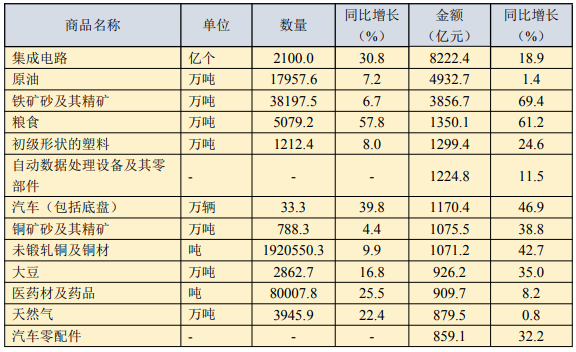
(8) Cross-border e-commerce continues to grow rapidly
Cross-border e-commerce continues to develop well and has become one of the main driving forces of foreign trade growth. In the first quarter, the customs’ full-caliber cross-border e-commerce import and export was 419.5 billion yuan, a year-on-year increase of 46.5%, contributing 7% to the import and export growth in the same period. Among them, exports were 280.8 billion yuan, an increase of 69.3%; imports were 138.7 billion yuan, an increase of 15.1%. More than 100 overseas warehouses were added, with an average area of 15,000 square meters.
(9) Continuous optimization of the structure of service trade
From January to April, China’s total import and export of services was 1,564.45 billion yuan, an increase of 3.3% year-on-year, and an average decline of 5.3% over the two years. Among them, exports were 746.21 billion yuan, a year-on-year increase of 23.2%, and the two-year average growth was 9.8%; imports were 818.24 billion yuan, a year-on-year decrease of 10%, and the two-year average fell by 14.7%. The growth rate of exports was 33.2 percentage points higher than that of imports, which drove the trade deficit to fall by 76.3% to 72.04 billion yuan. The proportion of knowledge-intensive service trade increased, with imports and exports of 732.53 billion yuan, an increase of 14.9%, accounting for 46.8% of the total service imports and exports, an increase of 4.7 percentage points over the same period last year.
Since 2021, China’s foreign trade has continued its growth momentum, mainly due to the following factors: First, the overall planning of epidemic prevention and control and economic and social development policies and measures are effective, and the economy continues to stabilize and recover; second, global economic and trade activities have gradually recovered and the market Confidence continues to increase and external demand continues to improve; third, the “low base” of the same period last year, the “in-situ Chinese New Year” during the Spring Festival this year, the export of epidemic prevention materials and the “home economy” products are driven by factors; fourth, the rebound of the epidemic in some countries or regions, and overseas supply capacity Affected by the shock, some orders were transferred to China; fifthly, the price increase of bulk commodities pushed up the growth rate of imports. In general, the high growth of foreign trade since 2021 is the result of a combination of many factors. It is expected that the growth rate of foreign trade for the whole year will show a trend of “high before and low afterwards”, and we cannot be blindly optimistic.
3. Analysis of China’s foreign trade development environment in 2021
The current epidemic is still spreading globally, vaccine production, distribution, and vaccination progress are uneven, the world economic recovery is unstable and uneven, the international industrial chain supply chain layout is profoundly adjusted, and the external environment facing China’s foreign trade development is still complicated. At the same time, we must also see that China’s economy is recovering steadily, new advantages in foreign trade competition continue to increase, and new business forms such as cross-border e-commerce are booming, which will provide strong support for the steady increase in volume and quality of imports and exports.
(Source: Ministry of Commerce)
(Editor in charge: DF545)
Solemnly declare: The purpose of this information released by Oriental Fortune.com is to spread more information and has nothing to do with this stand.
.
